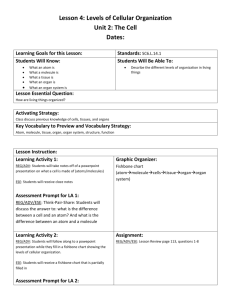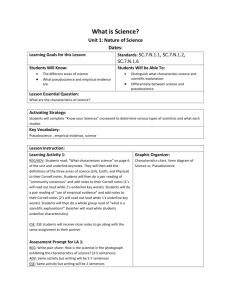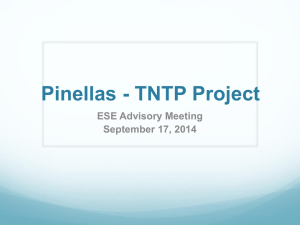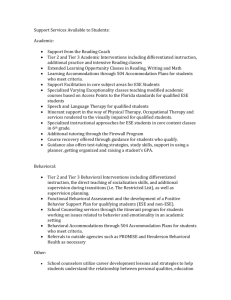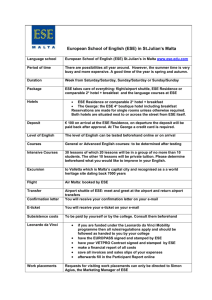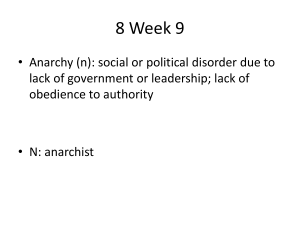Science-7-LEQ-1
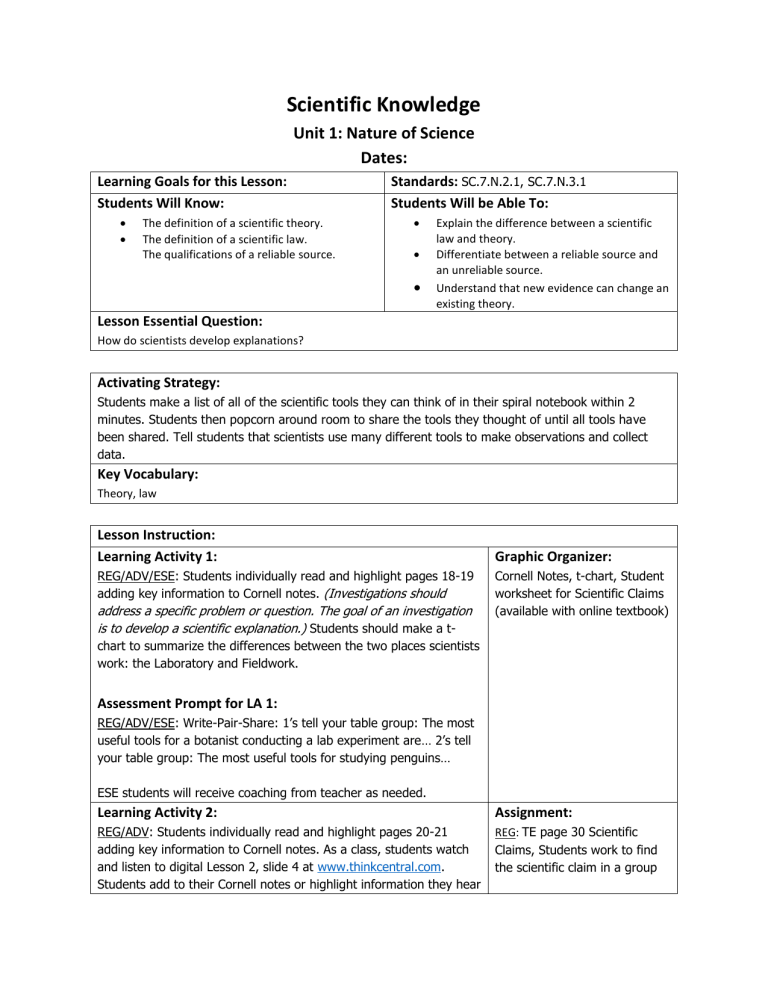
Scientific Knowledge
Unit 1: Nature of Science
Learning Goals for this Lesson:
Students Will Know:
The definition of a scientific theory.
The definition of a scientific law.
The qualifications of a reliable source.
Dates:
Standards:
SC.7.N.2.1, SC.7.N.3.1
Students Will be Able To:
Explain the difference between a scientific law and theory.
Differentiate between a reliable source and an unreliable source.
Understand that new evidence can change an existing theory.
Lesson Essential Question:
How do scientists develop explanations?
Activating Strategy:
Students make a list of all of the scientific tools they can think of in their spiral notebook within 2 minutes. Students then popcorn around room to share the tools they thought of until all tools have been shared. Tell students that scientists use many different tools to make observations and collect data.
Key Vocabulary:
Theory, law
Lesson Instruction:
Learning Activity 1:
REG/ADV/ESE: Students individually read and highlight pages 18-19 adding key information to Cornell notes. (Investigations should address a specific problem or question. The goal of an investigation is to develop a scientific explanation.) Students should make a tchart to summarize the differences between the two places scientists work: the Laboratory and Fieldwork.
Assessment Prompt for LA 1:
REG/ADV/ESE: Write-Pair-Share: 1’s tell your table group: The most useful tools for a botanist conducting a lab experiment are… 2’s tell your table group: The most useful tools for studying penguins…
ESE students will receive coaching from teacher as needed.
Learning Activity 2:
REG/ADV: Students individually read and highlight pages 20-21 adding key information to Cornell notes. As a class, students watch and listen to digital Lesson 2, slide 4 at www.thinkcentral.com
.
Students add to their Cornell notes or highlight information they hear
Graphic Organizer:
Cornell Notes, t-chart, Student worksheet for Scientific Claims
(available with online textbook)
Assignment:
REG: TE page 30 Scientific
Claims, Students work to find the scientific claim in a group
for a second time but is already in their notes. (Theory-explains many related observations, supported by a lot of evidence, may be modified; Law- a statement of fact that describes an action, always been observed to be true)
Think-Pair-Share: Students answer interactive quiz slide 6: Which statement is true about theories? (Theories may change as new evidence is presented.) If you conduct an experiment but the evidence doesn’t support your hypothesis, what do you do next?
(Revise the hypothesis, look for more evidence, design another experiment.)
ESE: Students will receive cloze notes
Assessment Prompt for LA 2:
REG/ESE:
Science Inquiry Lessons: Scientific Theories page 19.
Students conduct research on provided articles and/or websites to explore an example from history of scientific ideas or theories that were changed, replaced or rewritten in the face of newer evidence.
ADV: Students will do their own research to find their articles/websites
Learning Activity 3:
REG/ADV/ESE: Students read page 22 and add key information to
Cornell notes. As a class, students watch and listen to digital Lesson
2, slide 5 at www.thinkcentral.com
. Students add to their Cornell notes or highlight information they hear for a second time but is already in their notes. (Reliable Sources: peer review, results support or fail to support, results never prove anything)
Assessment Prompt for LA3:
REG: Write-Pair-Share: Students answer interactive quiz slide 7:
Which is a reliable source of information? (The Science journal) What type of websites should we look for when we are doing scientific research? (.edu or .gov, be careful or .org or .com, never Wikipedia, answers.com or ask.com, etc.) 3-5 sentences
ADV: same assessment but students will write 5-7 sentences
ESE: same activity but students will write 2 sentences
Summarizing Strategy:
REG/ADV/ESE: Students create a description wheel with Scientific Explanations in the center circle.
Spokes from the wheel should contain information from the lesson and notes. Students should do a thorough reflection of the lesson, using at least three colors to represent their ideas.
Student: Modification/Accommodation:
of provided magazine advertisements. Instruct student pairs to identify a scientific claim for which the evidence that supports the claim is presented, identify one in which the evidence that supports the claim is summarized but not actually presented, and identify one in which no evidence is summarized or presented.
Students should construct a written argument for why they placed each claim into its category and then share with the class.
ADV: Students (TE page 33) will find the ad with a scientific claim then conduct research to evaluate the validity of the claim. Students should use skepticism to write questions about the claim. Have students pair together to estimate how credible the sources seem based on the numbers and types of questions developed.
ESE: Students will be provided with only three ads to categorize.
1.
Seat student near teacher.
2.
Stand near student when giving directions/presenting.
3.
Provide visual aids/graphic organizers.
4.
Ensure oral directions are understood.
5.
Allow extra time to complete tasks.
6.
Simplify complex written directions.
7.
Give test items orally.
8.
Provide peer assistance/study groups.
